Probably, everybody has heard about Kickstarter, Patreon, and other similar platforms that help raise money for diverse ideas and projects. But few people know that these sites work for a reason: they charge 5% of the collected funds as a reward for intermediary services. This is a significant profit. In this article, we will tell you how to create a full-fledged analog of such a platform.
But first, let’s look through some numbers:
- The crowdfunding market share is projected to grow by the US $196.36 billion from 2020 to 2025, and the market growth rate will accelerate at a CAGR of 15%.
- Kickstarter has helped startups raise over $6.2 billion and have funded over 200,000 projects through the platform.
- Most successfully funded projects raise less than $10,000, but the number is growing, reaching six, seven, and even eight-figures. Currently funded projects that have achieved their objectives are not included in this chart – only projects that have completed a funding.
Table of Contents
- 1 What is a Crowdfunding Website and How Does it Work?
- 2 The 5 Key Business Models of Crowdfunding Platforms
- 3 Kickstarter Business Model
- 4 The List of Most Popular Websites for Crowdfunding
- 5 Crucial Features to Develop Crowdfunding Website
- 6 How to Create a Website Like Kickstarter in 10 Easy Steps
- 7 Actionable Tips to Make Your Crowdfunding Platform Unique
- 8 Technology Stack To Build A Crowdfunding Website from Scratch
- 9 How Much Does it Cost to Create a Crowdfunding Platform Like Kickstarter?
- 10 Conclusion
What is a Crowdfunding Website and How Does it Work?
First, let’s start with the definition of crowdfunding. So, crowdfunding is a way to raise money to fund projects and businesses. This allows fundraisers to raise money from a large number of people. Crowdfunding is most often used by startups or growing businesses as a way to access alternative funds. It is an innovative way to find sources of funding for new projects, businesses, or ideas.

- A crowdfunding platform is a website that is needed to host and promote various startup projects. Simply put, it is a place where people can post their business ideas to raise money to make the potential projects a reality.
- The idea of crowdfunding is simple. The entrepreneur opens an account on the platform that suits him best. It indicates the funding method (if the platform offers several) and the desired amount. A campaign cannot run infinitely, so the platform limits the maximum campaign duration.
- In case the needed amount has been reached, the investor’s account is debited and the project manager receives funds. For its part, the platform takes a commission on the collected amount (usually from 5 to 12%) if the goal is achieved.
Creating a crowdfunding platform, you need to take care of both investors and creators. To provide the best experience, it is key to take into account the set of features required by sponsors and creators. There are three types of users on a crowdfunding website: admins, investors, and creators. Creators create a page to display their project details and prototypes using text, videos, and photos.
The creators of the project set the funding goal and timeline. Creators also create reward tiers for sponsors that promise specific amounts. The more the sponsor promises, the greater the reward. When a sufficient number of sponsors fund the project, the creator can develop and realize his vision. Depending on the complexity of the project, sponsors may have to wait months to see the finished product.
What is a Kickstarter?
Kickstarter is a crowdfunding website where creators can raise funds to bring their innovative ideas to life. It all started in 2002 when Perry Chen, co-founder of Kickstarter, wanted to organize a Kruder & Dorfmeister concert in New Orleans. The concert did not take place, but the Kickstarter idea was born. Perry came up with the concept of building a space where everyone could share their ideas with the public, and if other people liked the idea, they could give some money to help bring it to life.

- For a long time, the idea was just an idea. Then everything changed in 2007. It was then that Perry Chen met Charles Adler, a designer who proposed creating a website. The work was finished in 2009, and in April of that year, three friends officially announced the launch of the project.
- As of July 2021, about 20 million people have pledged to provide monetary support to any of the more than 500,000 projects launched on Kickstarter (whether successful or not). In addition, over 6.7 million people have supported more than one project on the crowdfunding site.
- From July 2012 to July 2021, a total of almost $6 billion was allocated to projects on the Kickstarter crowdfunding platform.
The 5 Key Business Models of Crowdfunding Platforms
Modern crowdfunding platforms come in many different types and forms, such as peer-to-peer, equity, business, profit sharing, or donation platforms, but you should choose the one that suits your project, business, or enterprise.
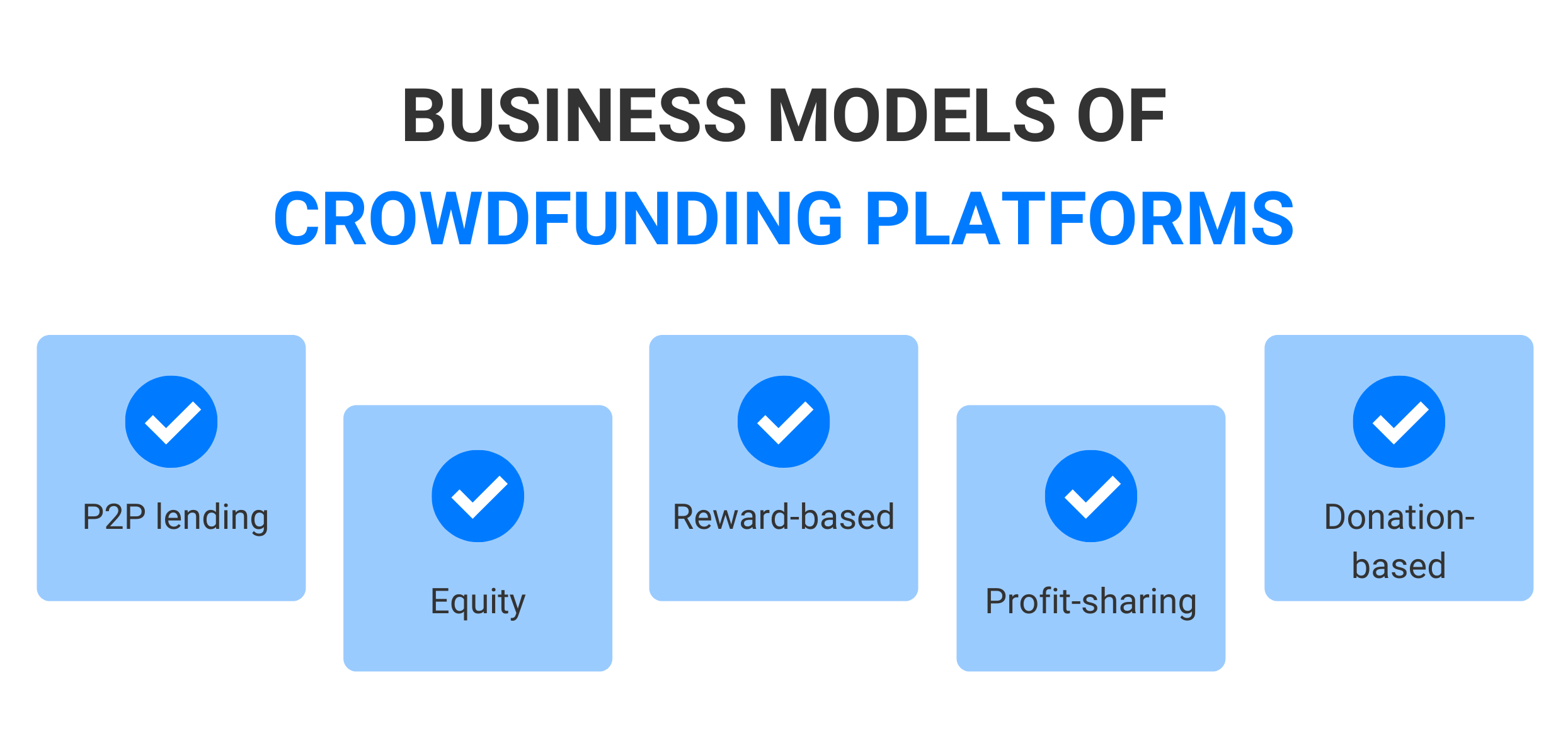
✅ Peer-to-peer lending
This type of crowdfunding platform involves a crowdfunding loan to the company. Users donate money to support a specific project, and after the campaign ends, a certain amount goes to the project owner.
✅ Equity
Сrowdfunding for business purposes, dedicated mainly to investments in business packages. The idea behind such a platform is very similar to the venture capital of conventional exchanges.
✅ Reward-based
People can participate in various projects in exchange for non-financial rewards – usually goods or services that the company produces.
✅ Profit-sharing
In this model, companies receive funding now in exchange for their future profits or earnings.
✅ Donation-based
Typically, these crowdfunding platforms are for charitable projects. After all, people can donate small amounts to cover larger funding.
Kickstarter Business Model
Before moving on to the development process, consider creating a crowdfunding website business plan. The Kickstarter business model includes:
✔ All-or-nothing strategy
IT means that the project receives money only if the required amount is reached. If this is not the case, no money will be charged from the sponsor cards and the creator will not receive funding.
✔ Time limits
Each campaign has its time frame for funding, and if the project does not receive the full amount by the “deadline”, the money will not be raised.
✔ Sponsor awards
Creators are required to provide rewards to sponsors.
✔ Anonymous
If sponsors do not wish to disclose their names, they can remain anonymous and swear an incognito oath.
Kickstarter’s purpose is to help startups get funding for their fledgling project. Besides, Kickstarter takes 5% of the raised money. Amazon, as a payment processor, charges an additional 3-5%.
The List of Most Popular Websites for Crowdfunding
Let’s look through some of the most well-known Kickstarter alternatives.
🔹 Indiegogo
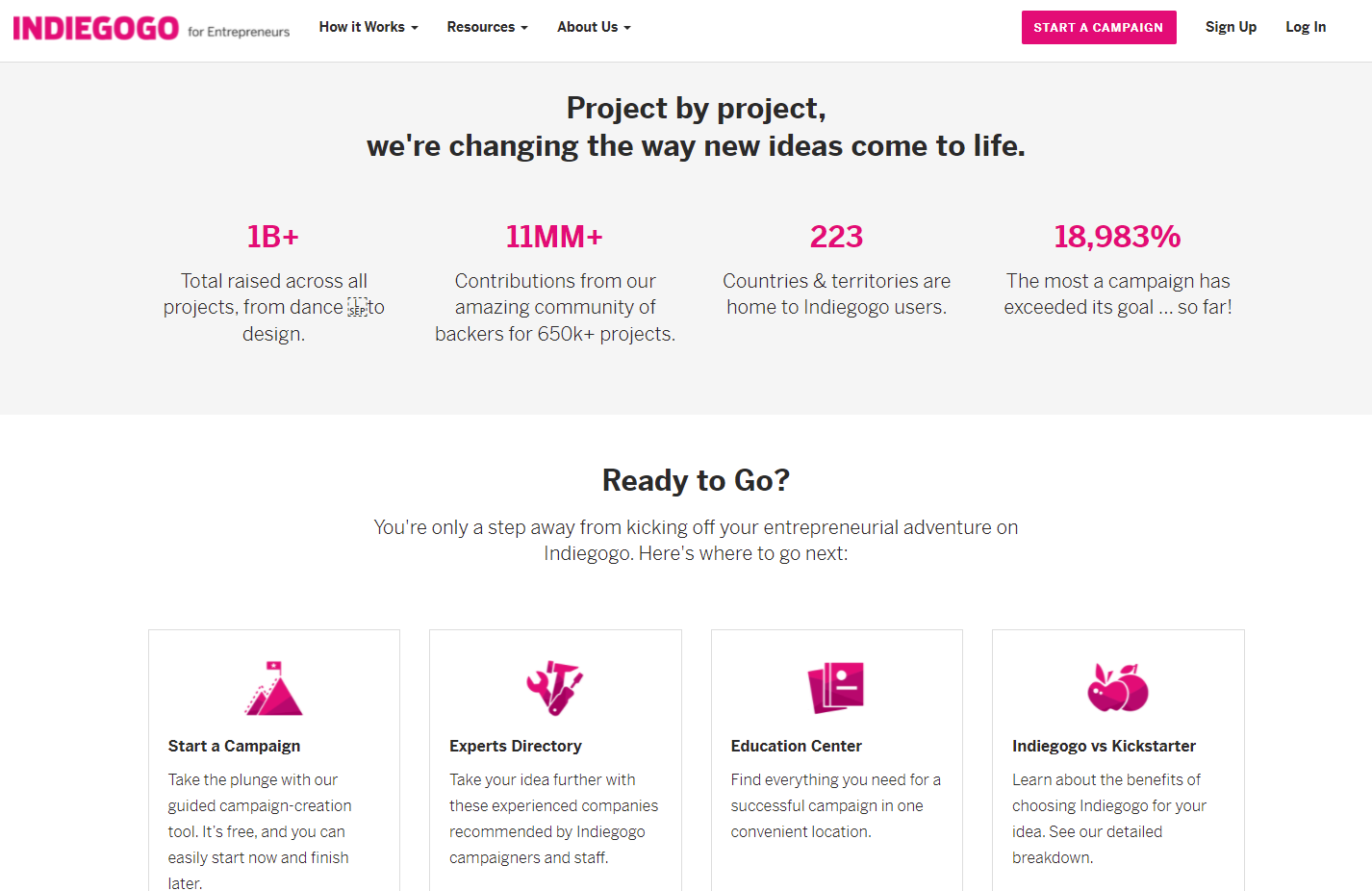
Launched in 2008, Indiegogo runs donation-based fundraising campaigns for a wide range of segments. It charges 9% of the funds raised and returns 5% if the campaign reaches its goal.
🔹 Kiva

Not all crowdfunding platforms are for money. Kiva is a non-profit organization using the concept of crowdfunding to reach those without access to financial institutions. The team has been working towards achieving the goal since 2005 and helping those in need around the world.
🔹 Crowdfunder
Crowdfunder is a platform for startups and social enterprises. The team is recognized for building investment ecosystems and connecting fundraising businessmen with local investors.
🔹 Crowd Supply
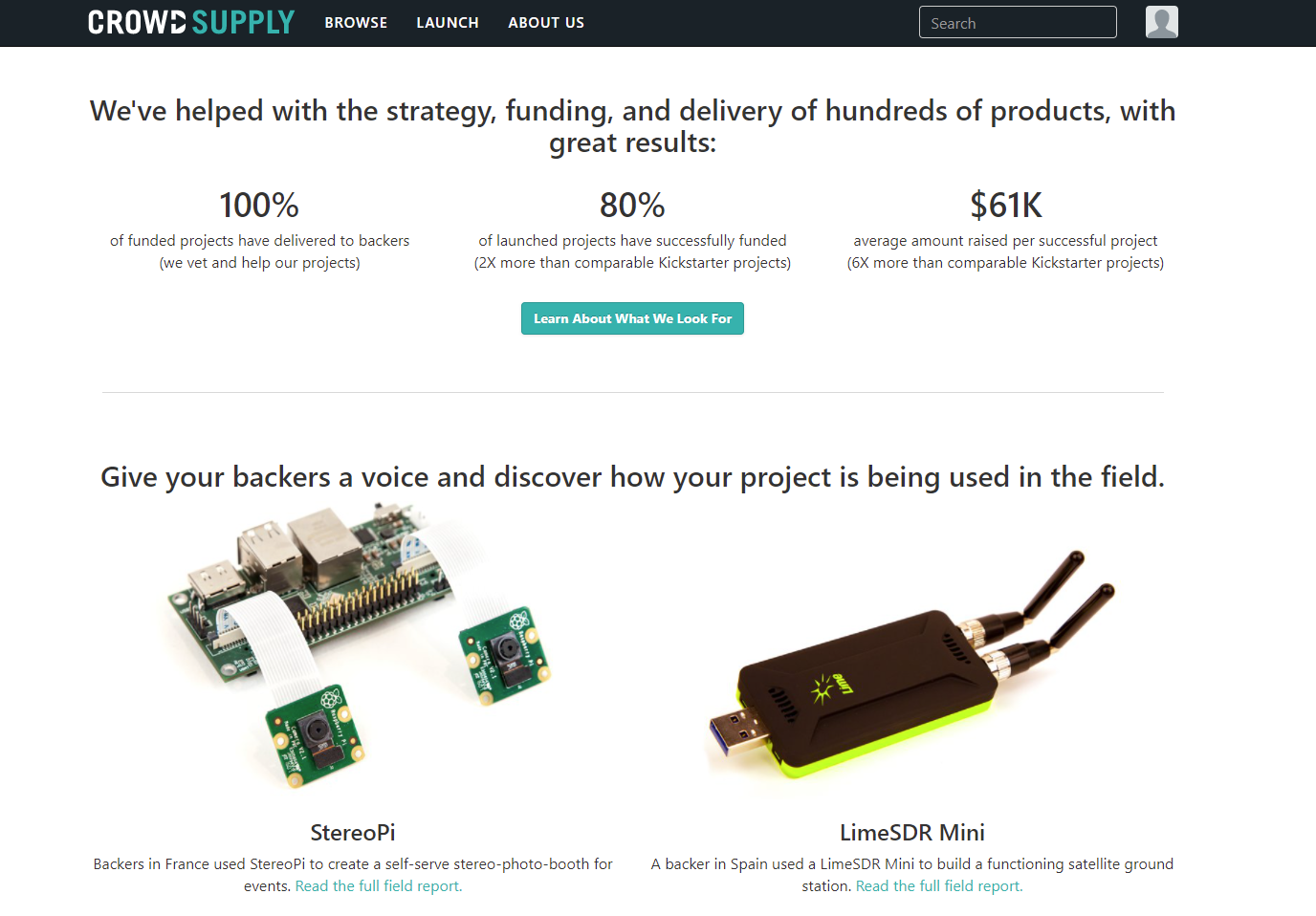
Crowd Supply goes one step further by helping manufacturers and innovators with physical product projects. It is not only a fundraising platform but also an online store that promotes sales. It features products from a wide variety of categories.
🔹 Fundable
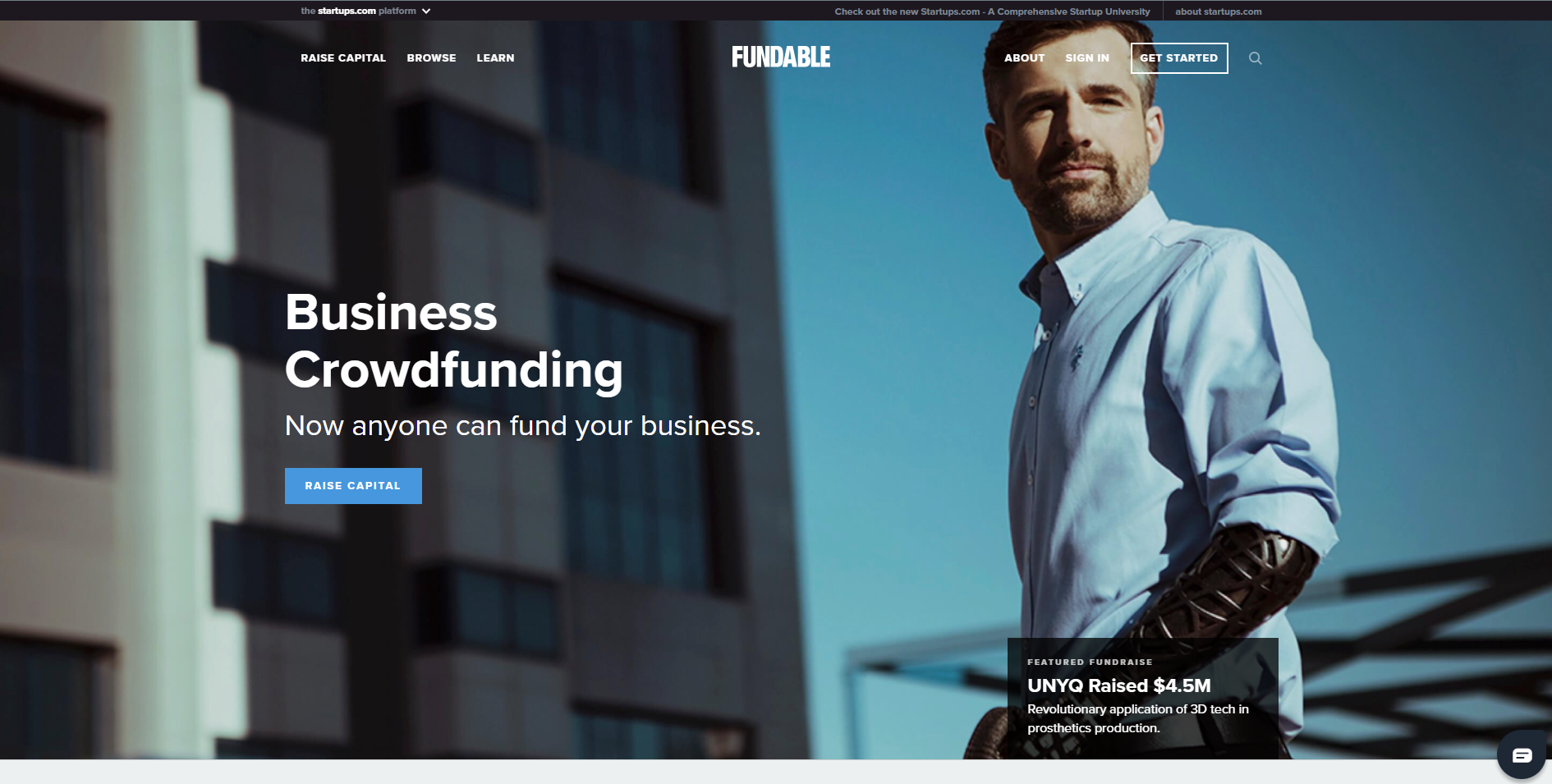
Fundable offers both reward-based campaigns and promotions for small businesses. The platform does not take any percentage of the campaign but charges up to $180 for each month of the campaign.
Crucial Features to Develop Crowdfunding Website
Below we describe the set of features for each type of user.
Feature Set for Creators
⚙ Registration
It’s key to give an opportunity to register using email and password or using social networks accounts.
⚙ Authorization and accounts
Creators need to log in using an email address or phone number and be able to reset passwords.
⚙ Profiles
Creators should be able to submit information about themselves and their teams and add an avatar.
⚙ Project management
Users need an opportunity to build projects to get money. Thus, they should be able to add project descriptions, videos, photos, and business plans.
⚙ Manage your investments
Campaign creators need to view the details of contributions, see how much they’ve raised, and see if they’ve met their goals.
Feature Set for Investors
⚙ Registration
To make registration smooth, allow sponsors to register not only with email but also using social networks accounts.
⚙ Authorization
Allow sponsors to log into their accounts with email and password, update their phone numbers, change passwords, and delete their accounts.
⚙ Profiles
Sponsors should be able to select an avatar and provide brief information about themselves.
⚙ Project exploration
Investors need an opportunity to view the profiles of the projects they like, which should contain detailed descriptions, videos, photos, and overviews of the risks and opportunities of the project.
⚙ Payments
Sponsors should be able to select payment methods, manage transactions, and get their money back if the project is not fully funded.
Feature Set for Admins
⚙ Account management
Adminis needs to filter and sort author and sponsor lists. It’s also critical to be able to ban users if they break the rules.
⚙ Admin accounts
Separate accounts help define which administrator made specific changes. It increases the transparency of the change history on the website so that changes can be rolled back in the event of an administrator error.
⚙ Project and category management
Admins need to sort project lists, read project descriptions, and deactivate projects if they violate platform rules. They also need an opportunity to add or remove categories from the list.
⚙ Investment and transaction management
In case of transaction issues, admins need to view payment details and report errors to customers.
⚙ Support
Admins have to control and filter contact requests and be able to read reviews from investors and creators.
How to Create a Website Like Kickstarter in 10 Easy Steps
Now, when you are familiar with all the critical points about crowdfunding website development, we can move on to the workflow. The Code&Care team created for you a simple step-by-step guide.
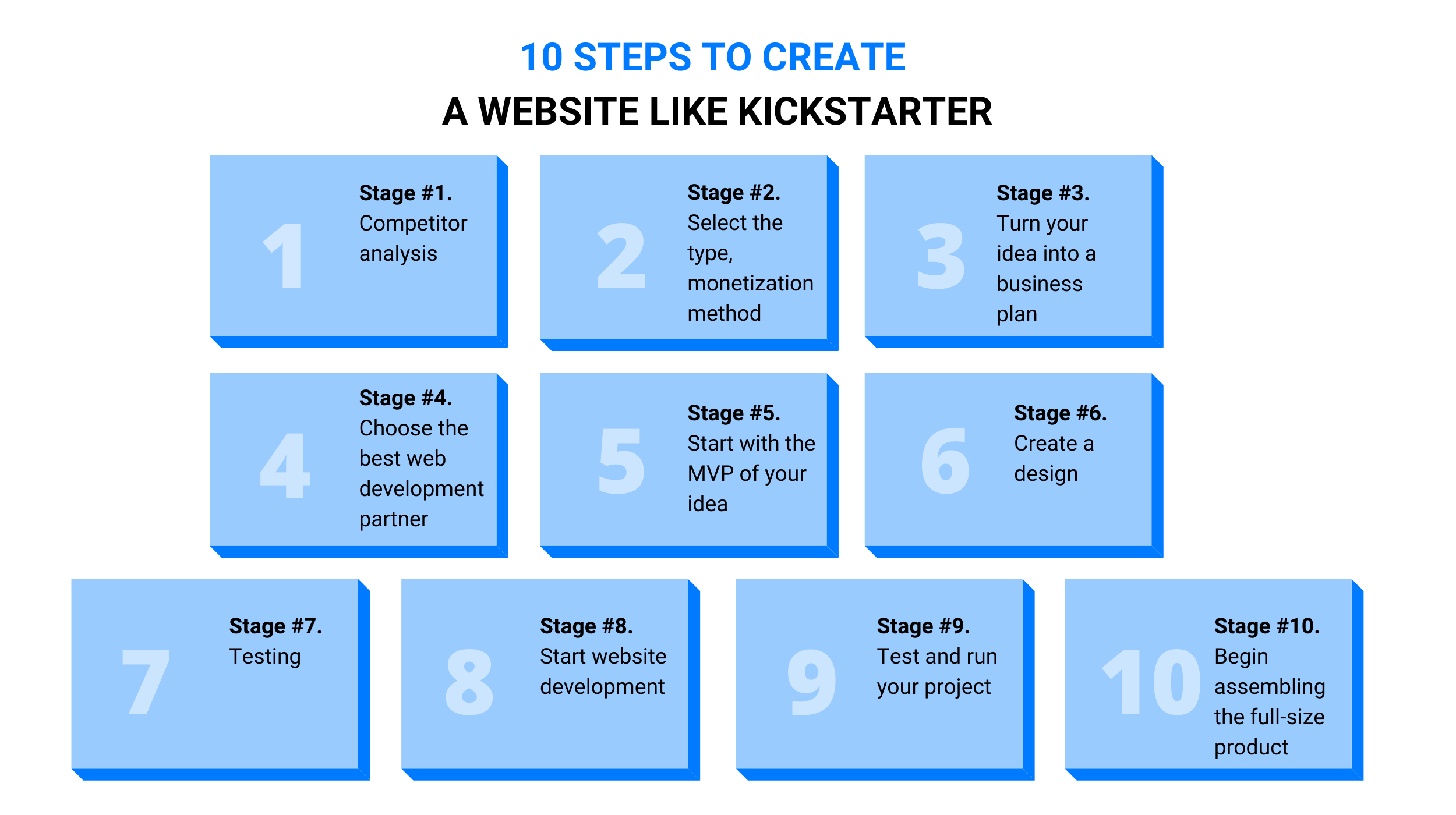
Stage #1. Analyze the way competitors are performing
Analysis of competitors’ platforms is key. It will help you get the way they are building a crowdfunding website. Before getting started, we recommend comparing platforms based on three points: the way of financing, the rate of the platform, the audience.
Stage #2. Select the type, monetization method, and target audience
After completing the analysis, you can choose the optimal crowdfunding business model to launch your crowdfunding site. Literally how your site will attract money from investors and on what terms.
Stage #3. Turn your idea into a business plan
A real budget is required to run a crowdfunding campaign. The budget defines the resources the company needs to “use” the cash and balances costs and benefits so that the company’s cash flow is always positive. There are expected costs involved in creating the video presentation of the project, press releases, and digital content needed to promote your crowdfunding operation. In addition, there are platform costs and, depending on the type of funding desired, any legal or audit costs.
Stage #4 Choose the best web development partner
When developing a successful crowdfunding campaign, the development team must set a clear goal – the site must be recognizable and targeted to the target audience. Upon entering the platform page, the user should immediately understand what the site is focused on and how to perform certain actions: register, launch a project, view a listing, invest money.
Stage #5. Start with the MVP of your idea
Once you know exactly what kind of crowdfunding platform you want to build, you can start building your MVP. This is best done using prototyping techniques. Its essence is to take on the efforts, desires, pleasures, preferences, and behavioural patterns of user characters and match them with the functions of the platform being created.
Stage #6. Create a design
Creating a crowdfunding site, always focus on the target audience and create design and features specifically for it. However, make sure that the interface of the site remains familiar and understandable, otherwise, visitors feel uncomfortable using the website.
Stage #7. Testing
After creating the prototype of the crowdfunding platform, it must be tested: first with the help of QA specialists, and when most of the errors and shortcomings will be eliminated with the help of real users. The approaches can be completely different.
Stage #8: Start website development
The most voluminous stage of launching a crowdfunding platform is writing the code of the site, testing it, and deploying it. You can start a crowdfunding design from scratch, which is long and expensive, but gives you maximum control and allows you to create a truly unique website. Or you can use templates and ready-to-use solutions on the Internet.
Stage #9. Test and run your project
Launching your website should be a big deal, or rather, you should be doing it. This will attract maximum attention to the crowdfunding site. To do this, you need:
- Find authors of several interesting and worthwhile crowdfunding campaigns who will agree to use your platform for fundraising. Make sure early initiatives raise money as quickly as possible.
- Organize email marketing and social media campaigns ahead of time.
- Make discounts available on all projects at launch.
Stage #10. Begin assembling the full-size product
Having a ready and successfully tested prototype, you can continue developing the platform, adding some extra features.
Actionable Tips to Make Your Crowdfunding Platform Unique
There are already many crowdfunding platforms on the market. When you are wondering how to launch a crowdfunding website, think about the fact that you need to not only create a project “like Kickstarter”, but also make it different in a certain way to stand out in the market.

- Tip #1. Select a niche
Kickstarter is all about crowdfunding creative projects. Some crowdfunding platforms try to focus on only one category: this approach narrows the target audience, but at the same time makes it much easier to attract it. So who said you can’t pick a specific niche to focus on? When you are about to launch a crowdfunding site, look around – many areas need to be supported, such as health, business, stocks, local initiatives, science, etc. - Tip #2. Add features that no one else has
Think about the unique features every time you ask yourself the question of how to create a crowdfunding website. Think about how you can update the platform: enable social interaction, let people find like-minded people and create campaigns together, launch a creative lab – all unique will increase customer interest in your project. - Tip #3. Provide a convenient user experience
The overall value of user-friendliness is to make your interface simple and even intuitive to use: your customers should have no difficulty navigating your platform. But you can go further: make your site fun to use.
Technology Stack To Build A Crowdfunding Website from Scratch
When you are just starting a crowdfunding platform development, selecting a set of technologies can be a question of time and budget. As we mentioned above, the best thing to do when creating a project is to start with the MVP: the first implementation of a product that has the minimum set of features necessary to keep the product in working order and attract the first clients and the attention of future sponsors.
At this stage, we advise selecting technologies that will save you time and budget. The Code&Care team recommends you to choose one from the following options:
🔹 The first one is to select PHP for back-end development, Vue.js for front-end development, and MySQL and Redis use as a database.
🔹 The second one is to use Node.js for back-end, React.js for front-end development, and PostgreSQL and MongoDB as a database.
✔ We advise you to choose for payment Stripe or Paypal.
✔ Possible third-party integrations are Google Services (Maps, Drive, Gmail, etc), Google Authenticator, Facebook authentication, Apple Authentication, QuickBooks.
✔ The perfect tools for support features are Zoho Desk or Monday.com integration.
How Much Does it Cost to Create a Crowdfunding Platform Like Kickstarter?
If you think about a development crowdfunding platform from scratch then you probably want to know its cost. The organization of a website like Kickstarter is not bound to the development and social media views. Other stages are also important:
- Hiring employees;
- Formation of a technical support base;
- Obtaining permits and licenses.
And this is not a complete list. The final cost may vary from $40 000 to $80 000 depending on the capabilities and needs of the team (specialist) implementing the project. The other factors that have to be considered are the selected programming languages, the complexity of design, the number of integrations, etc.
The best option is to contact the Code&Care team for a full consultation and preliminary estimate.
Conclusion
To create a space in which an organization can maintain a relationship with the Internet community, it is necessary to develop a dedicated platform, spending a sufficient amount of money and time. Our company offers services for the creation of crowdfunding platforms that allow you to draw attention to your project and raise the necessary funds.
Due to the wide possibilities of crowdfunding, more people will be able to learn about your project and take part in it. Code&Care offers solutions for opening new portals and adding crowdfunding functionality to an existing site.
📌 Read also:
















Popular
Latest